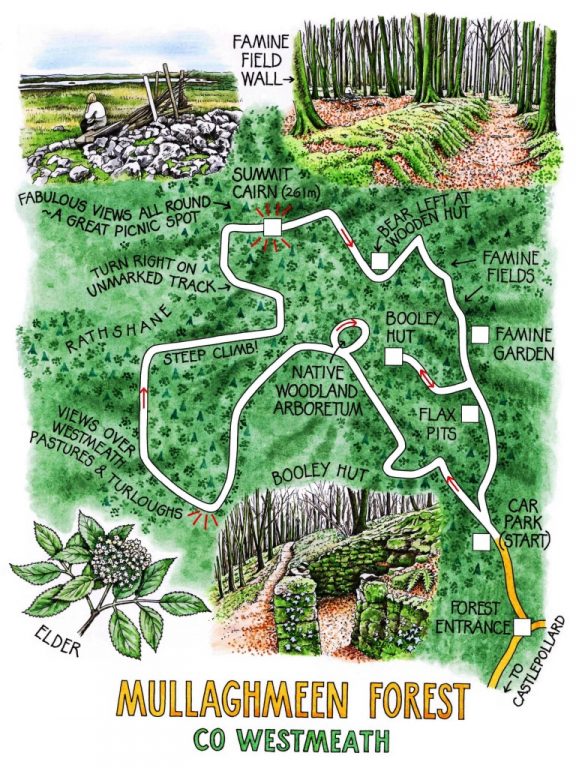Irish Independent – WALK OF THE WEEK – Christopher Somerville
4 September 2010
73. Mullaghmeen Forest, Co. Westmeath

There are woodland walks so boring you think you’ll scream if you see another wretched conifer; and then there are woodland walks like those in Mullaghmeen Forest up in the northernmost tip of Co Westmeath. The great thing about Mullaghmeen, apart from its location as a delightful surprise in a Midlands county not exactly celebrated for its walking grandeurs, is its huge variety. There are certainly sitka spruce, Scots pine and fir trees; but the 400 hectares of Mullaghmeen, founded on fertile limestone and threaded with waymarked trails, also contain the most extensive planted beech forest in Ireland. That means beautiful colours in spring and autumn, carpets of bluebells in early summer, and plenty of dappled sunlight penetrating the leafy canopy of the wood.
A calm, cool morning, and the slender beech trunks of Mullaghmeen Forest made a haze of pinky-grey on their hill. Among the trees it was wonderfully quiet and peaceful, each footfall muffled in a shroud of leaves. The hillsides were lumpy with limestone outcrops just under a green velvet skin of moss. We stopped on the path up through the wood to watch a chaffinch pecking and hopping among the leaves at our feet, quite unafraid. I thought I heard the tinkling, metallic trilling of a wood warbler, but if so the olive and yellow songster was keeping well out of sight.
Up on the hill a section of the forest has been planted with native Irish species, a welcome but tiny drop in the ocean of trees that the country needs. At the turn of the 20th century only 1% of Ireland enjoyed tree cover; all the rest had been chopped and burned over the millennia to clear land for farming. Nowadays, thanks to the efforts of Coillte and private landowners, one hectare in ten is under trees, though not enough are natives of the kind labelled and growing here in the Mullaghmeen arboretum: whitebeam, hornbeam, wild cherry and bird cherry, whitethorn and blackthorn, crab apple and spindle, alder and elder, beautiful names with poetry running through them.
Now the path dipped to skirt the south-west margin of the wood, with views out across the undulating pastureland of Westmeath, winking with turloughs or seasonal lakes half full after recent rain. The track sloped steeply up from Rathshane, curled aside and climbed out of the trees onto the heathery nape of Mullaghmeen hill. Up by the summit cairn at 261 m, we weren’t exactly reaching for the oxygen and yak-skin mittens, but we were the highest creatures in low-rolling Westmeath. Were those really the Wicklow Hills, 50 miles away on the south-east skyline; the Cuilcaghs or the Iron Mountains, 40 miles off on the opposite rim of the compass? Maybe wishing made them so. But there certainly was a superb prospect of the dark waters of Lough Sheelin, spread below with its islands and broad-headed peninsulas at the meeting point of Cavan, Meath and Westmeath.
Forests swallow ancient landscapes, as they would swallow us and all our works, given half a chance. Down below the summit, mossy humps under the beech trees showed where tiny squared-off famine fields, each carefully embanked, had been absorbed by the ever-growing wood. Up a marked side path I came to a roofless rectangle of stone, mossy and full of ferns, its back wall the rocky face of the hillside – a lonely booley hut where transhumance herdsmen lived summer-long with their cattle, making cheese and butter. Among the trees further down the hillside gleamed boggy hollows, all that remains of the retting ponds where flax was once steeped to ‘ret’ or rot the inner stalk away from the precious fibres used for spinning.
The poignancy of these lost working landscapes, so central to the everyday lives of our forefathers, so utterly irrelevant in the modern world, stayed in my mind for the rest of the walk, and long afterwards too.
WAY TO GO
MAP: OS of Ireland 1:50,000 Discovery 41; downloadable map/instructions (highly recommended) at www.discoverireland.ie/walking or www.coillteoutdoors.ie
TRAVEL: Signposted from R394 Castlepollard-Finnea, and R154 Oldcastle-Mount Nugent
WALK DIRECTIONS: From car park follow ‘White Walk’/WW (white waymarks, white-topped posts) uphill. Detour round Native Woodland Arboretum; continue along WW. Short steep climb at Rathshane to higher path (WW and Red Walk/RW). Left along it; in 100 m pass RW turning on right (‘car park’); in another 350 m, turn right up wide, unmarked track. At edge of trees keep ahead; in 100 m track curves right and climbs to summit cairn. Continue along ridge track, descending into woods and bearing right to descend to RW. Left along it for 10 m; left by hut and bench up woodland path to meet WW. Right; follow back to car park. NB – Famine Fields and Garden off to left of WW. Booley Hut detour marked on right just beyond (right up path; in 300 m, right again to hut; return to WW). Flax Pits signed off WW to right, nearer car park.
LENGTH: 6 miles: allow 2½-3 hours
GRADE: Moderate
CONDITIONS: Well-surfaced woodland paths; good waymarking. There’s a buggy/wheelchair-friendly track from the car park to a viewing point with benches.
DON’T MISS … !
• Native Woodland Arboretum
• view from summit
• Famine Fields
REFRESHMENTS: Picnic
WALKING in IRELAND: Walking tour operators, local walks including Discover Ireland’s National Loop Walks, walking festivals throughout Ireland: www.discoverireland.ie/walking; www.coillteoutdoors.ie
Slieve League walking festival, Co Donegal, 11-12 September: Sliabhliagwalkers.com, or tel 0797-950-4252 or 087-207-1797.
INFORMATION:
Mullingar Tourist Office: Market Square (044-934-8650);
http://www.discoverireland.ie/eastcoast/visit/westmeath.aspx
csomerville@independent.ie